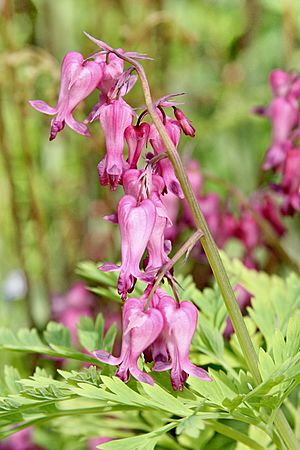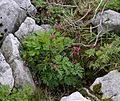Turkey corn facts for kids
Quick facts for kids Turkey corn |
|
|---|---|
 |
|
| Conservation status | |
| Scientific classification | |
| Genus: |
Dicentra
|
| Species: |
eximia
|
Dicentra eximia is a beautiful flowering plant often called the wild bleeding-heart or fringed bleeding-heart. It has pretty, fern-like leaves and unique, heart-shaped flowers. You can find this plant growing naturally in the Appalachian Mountains in eastern North America. It's a close relative of the Pacific bleeding-heart, which lives on the Pacific Coast. This plant is a perennial herb, meaning it lives for more than two years and its soft stem dies back each winter. It belongs to the Papaveraceae family, which also includes poppies.
Meet the Fringed Bleeding-Heart
The fringed bleeding-heart has lovely leaves that are divided into many small parts, making them look like ferns. They are a gray-green color and grow from the very bottom of the plant.
The Flowers are usually pink and grow in tight groups at the top of stems that don't have leaves. These stems are a bit thick and fleshy. The flowers bloom from mid-spring all the way into autumn. Each flower has four petals that are joined together at their base. The two outer petals look like little pouches and bend back at their tips. The two inner petals stand straight up and are connected at their tips. Inside these inner petals, you'll find the plant's pistil (the part that makes seeds) and two stamens (the parts that make pollen). There are also two tiny, pink, triangle-shaped sepals (small leaf-like parts) above the petals.
After the flowers bloom, the plant makes Seeds inside a plump, pointed pod. The seeds turn black when they are ready, even while the pod is still green. Each seed has a small, white, fatty part called an elaiosome. This part is a special treat for ants, which help spread the seeds around!
Sometimes, people confuse the Pacific bleeding-heart (Dicentra formosa) with Dicentra eximia because they look similar. However, the Pacific bleeding-heart has wider, more rounded flowers. Its outer petals also have shorter "wings" compared to the fringed bleeding-heart.
- Flower and fruit structure
Where Does it Grow?
The fringed bleeding-heart is native to the Appalachian Mountains. You can find it growing from southwestern Pennsylvania down to Tennessee and North Carolina. It usually grows in rocky woodlands, often at high elevations. It can be found anywhere from about 330 feet (100 meters) to 5,575 feet (1,700 meters) above sea level. This plant is very important for nature because it attracts hummingbirds and bees, helping them get nectar and pollen.
- Wild plants
-
A wild plant growing among rocks in Dolly Sods Wilderness, West Virginia.
Special Varieties
Just like there are different types of apples, there are also several special varieties, called cultivars, of Dicentra eximia. Some of these are hybrids, which means they are a mix of Dicentra eximia and other similar plants like Dicentra peregrina or Dicentra formosa.
Here are some examples:
- Dicentra eximia varieties
- Dicentra eximia 'Alba' — This variety has pretty white flowers instead of pink.
- Dicentra eximia 'Snowdrift' — This one also has white flowers, but they are larger.
- Hybrid varieties
- Dicentra 'Bountiful' — This is a mix of Dicentra formosa and Dicentra eximia, and it has rosy red flowers.
- Dicentra 'King of Hearts' — This hybrid has pink flowers and very finely cut leaves, almost like lace. It's a mix of three different bleeding-heart types!
- Dicentra 'Luxuriant' — A hybrid of Dicentra eximia and Dicentra peregrina, known for its bright cherry-red flowers.
- Dicentra 'Silversmith' — This variety has white flowers that are often flushed with a hint of pink.
- Dicentra 'Stuart Boothman' — This one likely comes from a mix of Dicentra formosa and Dicentra eximia, and it produces deep pink flowers.











